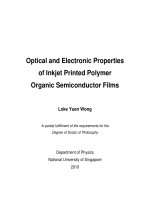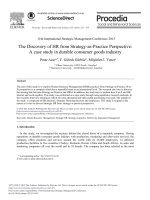Feature-rich electronic properties of germanene nanoribbons under fluorine doping effect: A DFT study
Bạn đang xem bản rút gọn của tài liệu. Xem và tải ngay bản đầy đủ của tài liệu tại đây (798.01 KB, 13 trang )
Feature-Rich Electronic Properties of Germanene Nanoribbons Under
Fluorine Doping Effect: A DFT Study
Vo Van On1 and Duy Khanh Nguyen1
1
Institute of Applied Technology, Thu Dau Mot University, Binh Duong, Vietnam,
Corresponding author:
ABSTRACTS
The first-principles calculations are carried out to study the structural and electronic properties
of fluorine-adsorbed germanene nanoribbons (GeNRs). Specifically, the feature-rich properties
are determined through the complete theoretical framework developed under the DFT
calculations, including the binding energies, optimal lattice parameters, atom-projected band
structures, orbital- and atom-projected density of states (DOSs), and charge density
distributions. Fluorine (F) adatom favorably adsorbs at the top site of GeNRs, regardless of
concentrations, edge structures, and distributions. The F adatom absorbs electron from GeNRs
to leave free hole in the system due to its very strong electron affinity that can be regarded as
the p-type doping. The F-doped systems belong to chemical adsorptions due to their large
binding energies, resulting in very strong chemical bonding in F-Ge. Whether the π bonding is
seriously distorted or terminated that directly determines the p-type metallic or semiconducting
behaviors. Under the single F adatom adsorption, the pristine GeNRs become the p-type metal
with high free hole density. After the adsorption configuration with the concentration of 16.6%,
the bandgap of the adsorbent systems opened up as the concentration increased, these systems
became semiconductors. However, the configuration with 66.7% concentration is again semimetallic with a bandgap of 0.08eV. The feature-rich electronic properties of GeNRs induced by F
adatom doping effect are suitable for various applications in electronic devices.
Keyword: germanene, germanene nanoribbons, halogen, adsorption, band structure, and
electronic applications.
66
Các tính chất giàu đặc tính của các dải nano germanene hấp phụ nguyên
tử flo: Nghiên cứu DFT
Vo Van On1, Duy Khanh Nguyen1
1
Institute of Applied Technology, Thu Dau Mot University
TÓM TẮT
Các tính tốn ngun lý đầu tiên được thực hiện để nghiên cứu các đặc tính cấu trúc và điện tử
của các dải nano germanene 1D (GeNRs) hấp phụ nguyên tử flo. Cụ thể, các tính chất vật lý thiết
yếu được xác định thơng qua khung lý thuyết hồn chỉnh đã được phát triển thơng qua các tính
tốn DFT, bao gồm năng lượng liên kết, các thông số mạng tối ưu, cấu trúc vùng điện tử, mật độ
trạng thái (DOS) và mật độ điện tích khơng gian. F hấp phụ ưu tiên nhất ở vị trí top của GeNRs,
bất kể nồng độ, cấu trúc cạnh và sự phân bố nguyên tử F. F hấp thụ điện tử từ GeNRs để sinh ra
các lỗ trống tự do do ái lực điện tử rất mạnh của nó, q trình này có thể xem là pha tạp loại p.
Hấp phụ F lên GeNRs tạo ra năng lượng hấp phụ lớn, có thể xem xét như hấp phụ hóa học. Liệu
là liên kết π bị biến dạng nghiêm trọng hoặc kết thúc trực tiếp xác định tính chất kim loại hoặc
chất bán dẫn loại p. Dưới sự hấp phụ đơn nguyên tử F, các GeNR nguyên sinh trở thành kim loại
loại p với mật độ lỗ trống cao. Khi hấp phụ với nồng độ 16,6%, độ rộng vùng cấm mở ra và các
hệ thống này trở thành chất bán dẫn. Tuy nhiên, cấu hình có nồng độ 66,7% lại là bán kim loại
với độ rộng vùng cấm 0,08 eV. Các đặc tính điện tử phong phú của GeNRs khi hấp phụ F có thể
dẫn đến các tính chất điện tử phong phú phù hợp cho nhiều ứng dụng điện tử.
Từ khóa: germanene, dải nano germanene, flo, hấp phụ, cấu trúc vùng điện tử và tính tốn DFT.
1. Introduction
Recently, two-dimensional hexagonal lattice such as silicene and germanene have attracted
special attention. They have a warped honeycomb structure of sp3 and sp2 hybridization in
reverse to the planar honeycomb lattice of graphene. Despite this difference, they exhibit some
similarities to graphene in electronic and physical properties and also exhibit semi-metallic
nature with no band gap [1-3]. Fabrication of germanene sheets on Pt(111)[4], Ag(111)[5],
Al(111)[6], Au[7] and Ge2Pt [8] crystals was performed. It has been suggested that silicene and
67
germanene are expected to enhance the performance and scalability of current Si-based
nanotechnology [9]. Notably, the special mechanical properties of silicene and germanene make
them candidates for the design of sensing applications [1, 10]. Unlike the two-dimensional
structure, nanobands can create an electron band gap and thus they may be promising candidates
for next-generation integrated circuit (IC) device components. such as transistor channels [11]
and sensors [12]. Germanene carbon nanotubes were experimentally synthesized by Han et al.
[13]. They exhibit interesting properties similar to those of graphene nanoribbons [14-16].
Theoretical studies of electronic properties have established that armchair germanene 4
nanobands are non-magnetic semiconductors with a direct band gap at the point Γ [17]. Like
graphene, the adsorption of organic and conventional gas molecules on germanene
nanostructures has also been reported and its application as a gas sensor has been examined [1820]. The atomic binding for germanene is much stronger than for graphene, and the calculated
adsorption energy for germanene is higher than that of the molecules adsorbed on graphene and
silicene [21]. In fact, germanene could be a promising candidate in the field of bioelectronics
[22]. While the adsorption of common gases on 2D germanene sheets and germanene
nanostructures has been studied extensively, the adsorption of atoms, especially highly
electronegative atoms such as F, on germanene nano bands has not been thoroughly studied.
Therefore, our objective is to study the adsorption properties of the F atoms on germanene
nanoribbon in this paper. The main objective of this paper is to understand the most stable
adsorption configurations, binding energies, densities of states, specific densities of states, and
region structures of the system. Furthermore, the charge density redistribution was also studied.
The paper is planned as follows: in section 2, the computational method is presents; section 3
presents the adsorption configuration; the adsorption energy in section 4; band structure and
density of state in section 5; the charge distribution in section 6; The conclusion of the paper in
section 7.
2. Computational Method
To perform the current density functional theoretical (DFT) calculations, Vienna ab initio
Simulation package (VASP) was employed [23]. Using the Perdew–Burke–Ernzerhof (PBE)
potential under the frame of generalized gradient approximation (GGA) as the electronic
exchange and correlation potential was investigated [24, 25]. The convergence criteria of energy
68
and force were 1 × 10−6 eV and 0.01 eV/Å, respectively. The electronic structure calculations
were evaluated at the level of GGA-PBE. For plane wave expansion, an energy cutoff of 450 eV
was preferred. To sample the k-points in the Brillouin zone, a 1 × 1 × 13 Monkhorst-Pack kpoint mesh size was used [26]. To avoid the coupling effects between the layers, the vacuum
spacing of 18 Å perpendicular to GeNRGe plane was assumed.
3. The adsorption configuration
Nanoribbons germanene pristine consist of 12 atoms of Ge in zigzag form. It has 2 closed
strings and a half of open string, the top and the bottom of the nanoribbon are passivated by two
hydrogen atoms as shown in fig.1. The average bond length between Ge-Ge atoms increases as
the adsorbent concentration increases, while the bond distance between F atoms and Ge atoms
decreases as the adsorbent concentration increases. We also see that the maximum buckling of
the adsorbent systems is not much different as the concentration of F atoms increases; however,
the binding energy of the adsorption systems decreases markedly with the increase of the
adsorption concentration as shown in Table 1.
a. Pristine
b.
c. 1:6
1:12
d. 1:2
69
e. 2:3
f. 1:1
Figure 1. The pristine germanene nanoribbons and the adsorption configurations of F atoms on
Germanene nanoribbons with different concentrations.
Table 1. The parameters of adsorption configurations
The system
The average
bond length(Å)
Mininum distance
(Ge-K)( Å)
Maximum
Bukcling
Binding energy (eV)
Pristine GeNR
2.41
No
0.06
-60.11
1F.GeNR
2.44
1.83
0.10
-64.55
2F.GeNR
2.45
1.82
0.07
-69.63
6F.GeNR
2.51
1.79
0.06
-90.27
8F.GeNR
2.50, 2.51
1.79
0.09
-100.18
12F.GeNR
2.50, 2.51
1.79
0.15
-121.09
4. The adsorption Energy
To compare the most stable configuration, we first calculated adsorption energy (Ead) of
considered configurations. Following relation has been used for calculating the Ead,
Ead = Etotal - Esubstrate - Eatoms
(1)
Where Etotal , Esubstrate and Eatoms are the total energy of the the adsorption system, pristine
germanene nanoribbons, and F atoms adsorbed on germanene nanoribbons, respectively. As per
the definition adopted here, negative adsorption energy exhibits that the process is exothermic
while the magnitude signifies thermodynamic stability. The calculation results showed that the
adsorbed samples with the most stable adsorbed energy both are in top positions. Both
adsorptions of the configurations are chemisorption as are shown in table 2.
70
Table 2. The adsorption energy of systems
Configuration
Adsorption energy per atom K
(eV)
Band gap(eV)
Pristine GeNR
No
0.50
1F.GeNR.bridge
-2.96
No
2F.GeNR.bridge
-2.07
0.175
6F.GeNR
-3.50
0.72
8F.GeNR
-3.76
0.08
12F.GeNR
-3.71
1.33
From table 2, the adsorption energy per one F atom in the configurations 8F.NRGe is the
smallest, while that of the configuration 2F.GeNr is the biggest.
5. Band structure and Density of State
Figure 2 shows the band structure and the density of state of the pristine nanoribbon
germanene and the adsorption configurations of 1F.GeNR, 2F.GeNR, 6F.GeNR, 8F.GeNr , and
12F.GeNR. We can see from table 2 that the direct band gap of the pristine nanoribbon
germanene is 0.5 eV, it behaves the metallic property with the electrons predominating. The
electrons mainly concentrate in the valence region with low energy and the conduction region
with high energy. The adsorption configuration of 1F.GeNR is a metallic, while that of 2F.GeNR
and 8F.GeNR is semi metallic but the electron concentration is low in the region near Fermi
level. This is a consequence of more electrons shifting towards the F atom, reducing the charge
density on the substrate. Two adsorption configurations of 6F.GeNR and 12F.GeNR are metallic
with band gap is 0.72 eV and 1.33 eV, respectively.
71
pristine
1F.GeNR
2F.GeNR
6F.GeNR
8F.GeNR
12F.GeNR
Figure 2. Band structures and the density of state of adsorption configurations
From the graphs of the density of state of the pristine germanene nanoribbons and the adsorption
configurations in figure 2, we can see that they are completely symmetric, which indicates that
these configurations are not magnetized. Obtained calculation results also confirm that their
magnetizations all are zero. The figure 3 (a, b, c, d, e) show the part density of state of each
elements in the adsorption configurations.
72
1F.GeNR
2F.GeNR
6F.GeNR
8F.GeNR
73
12F.GeNR
Figure 3. PDOS of each element in the adsorption configuration of 1F.GeNR, 2F.GeNR, 6F.GeNR,
8F.GeNR, and 12F.NRGe.
From the graphs of the part density of states (PDOS) in fig 3, we can see that the
distribution of PDOS of Ge_S(orange solid line) is mainly in low energy region (valence region),
while that of PDOS of Ge_P(green solid line) is mainly in the region near the Fermi level and
high energy conduction region. The state density of F_S has a negligible contribution over the
entire energy range, it is significant in the valence region with very low energy, while the state
density of F_P is only significant in the low energy region below the Fermi level.
6. The charge distribution
Figure 4 shows the charge distribution in the adsorption configurations of 1F.GeNR,
2F.GeNR, 6F.GeNR, 8F.GeNR and 12F.GeNR.
a.
b.
74
,
c.
d.
e
f
Figure 4. The charge distribution of the adsorption configurations of 1F.NRGe, 2F.GeNR,
6F.GeNR, 8F.GeNR and 12F.NRGe
It is clear that the charge is pulled toward F atoms by the larger electronegativity of F
atoms comparable to Ge atoms, this decreases the charge concentration of the substrates. The
charge distribution of two strings of Ge atoms in the substrates are slightly different, the
distribution of the adsorption system of 2F.NRGe is symmetrically larger than another by two F
atoms on two sides of the substrate. The volume of the blue space region is due to the charge
reduction in the middle of the rings of Ge atoms of the 2F.NRGe configuration is larger and
more circular. The lower buckling in the 2F.NRGe configuration also affects the symmetry of
this charge-reducing blue region.
75
7. Conclusion
In conclusion, we studied the structural and electronic properties of adsorption systems of
adsorption configurations of 1F.NRGe, 2F.NRGe, 6F.GeNR, 8F.GeNR, and 12F.GeNR. Results
show that the bond lengths of Ge-Ge increase as the concentration of F atoms increase, while the
binding energy decrease; the adsorption property of all systems are chemical adsorptions; the
adsorption configuration of 8F.NRGe is the best stable with the adsorption energy of -3.76 eV,
while the configuration of 2F.GeNR is not the best stable with adsorption of -2.07eV. There is
the shift of charges from the substrates to F atoms due to the negativity difference between F and
Ge, H atoms. The results show that we can control the bandgap of nanoribbon germanene by the
change of the number of F atoms in the adsorption system. This is important in electronic
applications.
Acknowledgment: This research is funded by Thu Dau Mot University, Binh Duong
Province, Vietnam, and used resources of the high-performance computer cluster (HPCC) at
Thu Dau Mot University, Binh Duong Province, Vietnam.
References
[1] S. Balendhran, S. Walia, H. Nili, S. Sriram, M. Bhaskaran, Elemental analogues of graphene:
silicene, germanene, stanene, and phosphorene, small, 11 (2015) 640-652.
/>[2]. S. Cahangirov, M. Topsakal, E. Aktürk, H. Şahin, S. Ciraci, Two-and one-dimensional
honeycomb structures of silicon and germanium, Physical review letters, 102 (2009) 236804.
/>[3]. A. Dimoulas, Silicene and germanene: Silicon and germanium in the “flatland”,
Microelectronic engineering, 131 (2015) 68-78. />[4]. L. Li, S. Z. Lu, J. Pan, Z. Qin, Y. Q. Wang, Y. Wang, G. Y. Cao, S. Du, H. J. Gao, Buckled
germanene formation on Pt (111), Advanced Materials, 26 (2014) 4820-4824.
/>[5]. H. Oughaddou, S. Sawaya, J. Goniakowski, B. Aufray, G. Le Lay, J. M. Gay, G. Tréglia, J.
P.Bibérian, N. Barrett, C. Guillot, A. Mayne, Ge/Ag (111) semiconductor-on-metal growth:
Formation of an Ag 2 Ge surface alloy, Physical Review B, 62 (2000) 16653.
/>[6]. M. Derivaz, D. Dentel, R. Stephan, M.C. Hanf, A. Mehdaoui, P. Sonnet, C. Pirri, Continuous
germanene
layer
on
Al
(111),
Nano
letters,
15
(2015)
2510-2516.
/>76
[7]. M. E. Dávila, L. Xian, S. Cahangirov, A. Rubio, G. Le Lay, Germanene: a novel twodimensional germanium allotrope akin to graphene and silicene, New Journal of Physics, 16
(2014) 095002. />[8]. P. Bampoulis, L. Zhang, A. Safaei, R. van Gastel, B. Poelsema, H. J. W. Zandvliet,
Germanene termination of Ge2Pt crystals on Ge (110), Journal of physics: Condensed matter, 26
(2014) 442001. />[9]. S. Jiang, M. Q. Arguilla, N. D. Cultrara, J. E. Goldberger, Covalently-controlled properties
by design in group IV graphane analogues, Accounts of chemical research, 48 (2014) 144-151.
/>[10]. E. C. Anota, A. B. Hernández, M. Castro, G. H. Cocoletzi, Density Functional Theory
Studies of the Structural and Electronic Properties of Germanium Nanosheets, Journal of
Computational
and
Theoretical
Nanoscience,
10
(2013)
2264-2268.
/>[11]. E.M. Abhinav, D.V. Chary, Strain-induced on germanene monolayer 6nm short channel
FET from first-principle study. in International Conference on Circuits, Communication, Control
and Computing. 2014. IEEE. 10.1109/CIMCA.2014.7057743.27
[12]. A.H. Bayani, D. Dideban, N. Moezi, Hydrogen sensitive field-effect transistor based on
germanene nanoribbon and optical properties of hydrogenated germanene, Journal of
Computational Electronics, 15 (2016) 381-388. />[13]. W. Q. Han, L. Wu, Y. Zhu, M. Strongin, In-situ formation of ultrathin Ge nanobelts
bonded with nanotubes, Nano letters, 5 (2005) 1419-1422. />[14]. S. Cahangirov, M. Topsakal, S. Ciraci, Armchair nanoribbons of silicon and germanium
honeycomb
structures,
Physical
Review
B,
81
(2010)
195120.
/>[15]. L. Matthes, F. Bechstedt, Influence of edge and field effects on topological states of
germanene nanoribbons from self-consistent calculations, Physical Review B, 90 (2014)
165431. />[16]. S. Dong, C. Q. Chen, Stability, elastic properties, and electronic structure of germanane
nanoribbons, J Phys Condens Matter, 27 (2015) 245303. />[17] Q. Pang, Y. Zhang, J. M. Zhang, K. W. Xu, Functionalization of low-dimensional
honeycomb germanium with 3d transition-metal atoms, Computational Materials Science, 50
(2011) 1717-1724. />[18]. P. Rubio-Pereda, N. Takeuchi, Adsorption of Organic Molecules on the Hydrogenated
Germanene: A DFT Study, The Journal of Physical Chemistry C, 119 (2015) 27995-28004.
28
77
[19]. Y. P. Wang, W. X. Ji, C. W. Zhang, S. S. Li, F. Li, P. Li, M. J. Ren, X. L. Chen, M. Yuan,
P. J. Wang, Enhanced band gap opening in germanene by organic molecule adsorption,
Materials
Chemistry
and
Physics,
173
(2016)
379-384.
/>[20]. Q. Pang, L. Li, D. L. Gao, R. P. Chai, C. L. Zhang, Y. L. Song, Tuning the electronic and
magnetic properties of germanene by surface adsorption of small nitrogen-based molecules,
Physica E: Lowdimensional Systems and Nanostructures, 88 (2017) 237-242.
/>[21]. W. Xia, W. Hu, Z. Li, J. Yang, A first-principles study of gas adsorption on germanene,
Physical
Chemistry
Chemical
Physics,
16
(2014)
22495-22498.
/>[22]. D. Chimene, D. L. Alge, A. K. Gaharwar, Two-Dimensional Nanomaterials for Biomedical
Applications: Emerging Trends and Future Prospects, Adv Mater, 27 (2015) 7261-84.
/>[23] G. Kresse, J. Hafner, Ab initio molecular dynamics for liquid metals, Phys. Rev. B 47
(1993) 558.
[24 ] J.P. Perdew, K. Burke, M. Ernzerhof, Generalized gradient approximation made
simple, Phys. Rev. Lett. 77 (1996) 3865.
[25] P.E. Blochl, Projector augmented-wave method, Phys. Rev. B 50 (1994) 17953.
[26] H.J. Monkhorst, J.D. Pack, Special points for Brillouin-zone integrations, Phys.Rev. B 13
(1976) 5188.
78
![Structures and electronic properties of si nanowires grown along the [1 1 0] direction role of surface reconstruction](https://media.store123doc.com/images/document/14/rc/td/medium_tdu1394959072.jpg)








